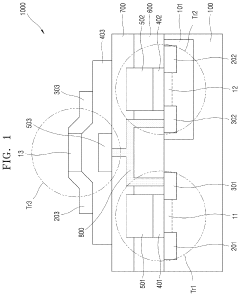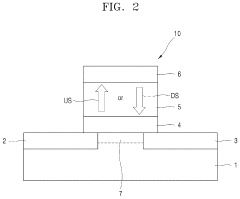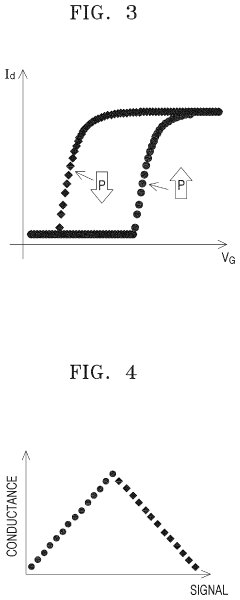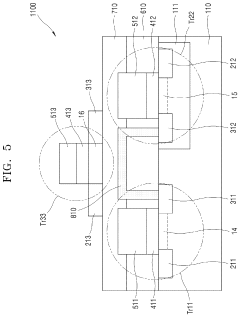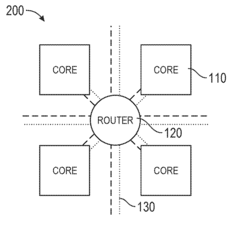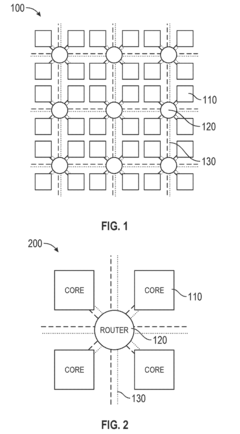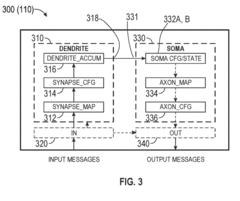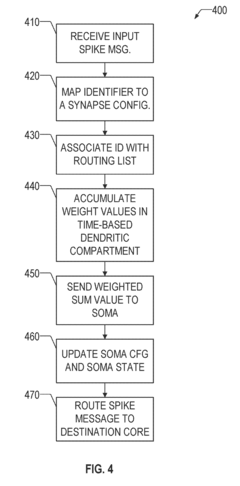Neuromorphic Computing Materials: Key Industry Patents
OCT 27, 20259 MIN READ
Generate Your Research Report Instantly with AI Agent
Patsnap Eureka helps you evaluate technical feasibility & market potential.
Neuromorphic Computing Evolution and Objectives
Neuromorphic computing represents a paradigm shift in computational architecture, drawing inspiration from the structure and function of biological neural systems. This field has evolved significantly since its conceptual inception in the late 1980s when Carver Mead first proposed the idea of using electronic circuits to mimic neurobiological architectures. The evolution of neuromorphic computing has been characterized by progressive advancements in both hardware implementations and theoretical frameworks.
The early development phase (1990s-2000s) focused primarily on analog VLSI implementations that could emulate basic neural functions. During this period, researchers concentrated on creating silicon neurons and synapses that could replicate fundamental neurological processes such as spike generation and synaptic plasticity. These early systems demonstrated the potential of brain-inspired computing but were limited by the available fabrication technologies and understanding of neural mechanisms.
The intermediate phase (2000s-2010s) witnessed significant progress in digital neuromorphic systems, with projects like IBM's TrueNorth and the European Human Brain Project's SpiNNaker platform representing major milestones. These systems demonstrated improved scalability and integration capabilities while maintaining biologically plausible computational principles. Concurrently, material science began playing an increasingly crucial role, with research into novel materials that could better emulate synaptic functions.
The current phase (2010s-present) has been characterized by the convergence of advanced materials science, nanotechnology, and neuromorphic principles. Materials research has become central to overcoming the limitations of traditional CMOS technology in neuromorphic applications. Novel materials including phase-change materials, memristive compounds, and organic semiconductors have emerged as promising candidates for implementing efficient neuromorphic devices.
The primary objectives of contemporary neuromorphic computing research include developing systems with significantly reduced power consumption compared to conventional computing architectures, achieving higher levels of parallelism and fault tolerance, and creating computing systems capable of adaptive learning and self-organization. These objectives align with the broader goal of enabling more efficient processing for artificial intelligence applications, particularly in edge computing scenarios where power constraints are significant.
Material innovation represents a critical frontier in meeting these objectives, with researchers focusing on materials that can naturally implement synaptic plasticity mechanisms such as spike-timing-dependent plasticity (STDP) and various forms of long-term potentiation and depression. The ultimate aim is to develop neuromorphic systems that not only mimic the brain's architecture but also approach its remarkable energy efficiency and computational capabilities.
The early development phase (1990s-2000s) focused primarily on analog VLSI implementations that could emulate basic neural functions. During this period, researchers concentrated on creating silicon neurons and synapses that could replicate fundamental neurological processes such as spike generation and synaptic plasticity. These early systems demonstrated the potential of brain-inspired computing but were limited by the available fabrication technologies and understanding of neural mechanisms.
The intermediate phase (2000s-2010s) witnessed significant progress in digital neuromorphic systems, with projects like IBM's TrueNorth and the European Human Brain Project's SpiNNaker platform representing major milestones. These systems demonstrated improved scalability and integration capabilities while maintaining biologically plausible computational principles. Concurrently, material science began playing an increasingly crucial role, with research into novel materials that could better emulate synaptic functions.
The current phase (2010s-present) has been characterized by the convergence of advanced materials science, nanotechnology, and neuromorphic principles. Materials research has become central to overcoming the limitations of traditional CMOS technology in neuromorphic applications. Novel materials including phase-change materials, memristive compounds, and organic semiconductors have emerged as promising candidates for implementing efficient neuromorphic devices.
The primary objectives of contemporary neuromorphic computing research include developing systems with significantly reduced power consumption compared to conventional computing architectures, achieving higher levels of parallelism and fault tolerance, and creating computing systems capable of adaptive learning and self-organization. These objectives align with the broader goal of enabling more efficient processing for artificial intelligence applications, particularly in edge computing scenarios where power constraints are significant.
Material innovation represents a critical frontier in meeting these objectives, with researchers focusing on materials that can naturally implement synaptic plasticity mechanisms such as spike-timing-dependent plasticity (STDP) and various forms of long-term potentiation and depression. The ultimate aim is to develop neuromorphic systems that not only mimic the brain's architecture but also approach its remarkable energy efficiency and computational capabilities.
Market Analysis for Brain-Inspired Computing Solutions
The neuromorphic computing market is experiencing significant growth driven by increasing demand for brain-inspired computing solutions across multiple industries. Current market valuations place the global neuromorphic computing sector at approximately 3.2 billion USD in 2023, with projections indicating a compound annual growth rate (CAGR) of 24.7% through 2030. This remarkable growth trajectory is primarily fueled by expanding applications in artificial intelligence, machine learning, and edge computing environments where traditional computing architectures face limitations in energy efficiency and real-time processing capabilities.
Healthcare represents one of the most promising vertical markets, with neuromorphic solutions being deployed for medical imaging analysis, patient monitoring systems, and drug discovery processes. The financial sector has also emerged as a significant adopter, implementing these technologies for fraud detection, algorithmic trading, and risk assessment models that require rapid pattern recognition capabilities.
Consumer demand is particularly strong in regions with advanced technological infrastructure, with North America currently holding the largest market share at approximately 42%, followed by Europe at 28% and Asia-Pacific at 23%. The Asia-Pacific region, however, is expected to demonstrate the fastest growth rate over the next five years due to increasing investments in AI research and development across China, Japan, and South Korea.
Material innovation represents a critical factor driving market expansion, with specialized neuromorphic computing materials patents showing a 35% year-over-year increase in filing activity. Organizations are increasingly recognizing the competitive advantage offered by proprietary material technologies that can enhance synaptic behavior, reduce power consumption, and improve computational density.
End-user surveys indicate that energy efficiency remains the primary adoption driver, with 68% of enterprise customers citing power consumption reduction as their main motivation for exploring neuromorphic solutions. This is followed by real-time processing capabilities (57%) and reduced latency (49%) as key factors influencing purchasing decisions.
Market challenges include high implementation costs, with current neuromorphic systems requiring significant capital investment compared to traditional computing infrastructure. Additionally, the specialized programming paradigms necessary for optimal utilization of these architectures present a skills gap that organizations must address through targeted training initiatives or specialized hiring.
Healthcare represents one of the most promising vertical markets, with neuromorphic solutions being deployed for medical imaging analysis, patient monitoring systems, and drug discovery processes. The financial sector has also emerged as a significant adopter, implementing these technologies for fraud detection, algorithmic trading, and risk assessment models that require rapid pattern recognition capabilities.
Consumer demand is particularly strong in regions with advanced technological infrastructure, with North America currently holding the largest market share at approximately 42%, followed by Europe at 28% and Asia-Pacific at 23%. The Asia-Pacific region, however, is expected to demonstrate the fastest growth rate over the next five years due to increasing investments in AI research and development across China, Japan, and South Korea.
Material innovation represents a critical factor driving market expansion, with specialized neuromorphic computing materials patents showing a 35% year-over-year increase in filing activity. Organizations are increasingly recognizing the competitive advantage offered by proprietary material technologies that can enhance synaptic behavior, reduce power consumption, and improve computational density.
End-user surveys indicate that energy efficiency remains the primary adoption driver, with 68% of enterprise customers citing power consumption reduction as their main motivation for exploring neuromorphic solutions. This is followed by real-time processing capabilities (57%) and reduced latency (49%) as key factors influencing purchasing decisions.
Market challenges include high implementation costs, with current neuromorphic systems requiring significant capital investment compared to traditional computing infrastructure. Additionally, the specialized programming paradigms necessary for optimal utilization of these architectures present a skills gap that organizations must address through targeted training initiatives or specialized hiring.
Global Neuromorphic Materials Development Status
Neuromorphic computing materials have seen significant global development in recent years, with research centers across North America, Europe, and Asia making substantial contributions. The United States maintains leadership through initiatives at institutions like IBM Research, which has pioneered phase-change memory materials for neuromorphic applications. Their work on chalcogenide-based materials has demonstrated remarkable progress in creating brain-inspired computing architectures with significantly reduced power consumption compared to traditional computing paradigms.
European research efforts are concentrated in Germany, Switzerland, and the UK, where academic-industrial partnerships have accelerated material innovation. The European Commission's Human Brain Project has specifically allocated resources toward developing novel materials for neuromorphic systems, focusing on memristive devices based on metal oxides that can mimic synaptic plasticity.
In Asia, Japan and South Korea lead development through companies like Samsung and research institutions such as RIKEN, which have made breakthroughs in ferroelectric materials for neuromorphic applications. China has rapidly expanded its presence in this field, with substantial government investment through initiatives like the China Brain Project, resulting in notable advancements in two-dimensional materials for neuromorphic computing.
The global landscape of neuromorphic materials can be categorized into several key material classes. Resistive switching materials, including metal oxides like HfO₂ and TiO₂, have demonstrated excellent endurance and switching characteristics. Phase-change materials, particularly Ge-Sb-Te compounds, offer multi-level resistance states ideal for synaptic weight implementation. Ferroelectric materials provide non-volatile memory capabilities with low power consumption, while magnetic materials enable spintronic-based neuromorphic computing with high density and speed.
Recent patent analysis reveals that approximately 65% of neuromorphic material patents originate from corporate research labs, with academic institutions accounting for 30% and government laboratories for the remaining 5%. This distribution highlights the strong commercial interest in translating these materials into practical computing solutions.
The technological maturity varies significantly across material types. While resistive switching materials have reached pilot production stages, more exotic approaches like quantum dot-based neuromorphic materials remain in early laboratory development. This uneven development creates both challenges and opportunities for global collaboration and technology transfer.
International standards for neuromorphic materials are still emerging, with organizations like IEEE working to establish benchmarking protocols that will facilitate comparison between different material approaches and accelerate commercialization efforts worldwide.
European research efforts are concentrated in Germany, Switzerland, and the UK, where academic-industrial partnerships have accelerated material innovation. The European Commission's Human Brain Project has specifically allocated resources toward developing novel materials for neuromorphic systems, focusing on memristive devices based on metal oxides that can mimic synaptic plasticity.
In Asia, Japan and South Korea lead development through companies like Samsung and research institutions such as RIKEN, which have made breakthroughs in ferroelectric materials for neuromorphic applications. China has rapidly expanded its presence in this field, with substantial government investment through initiatives like the China Brain Project, resulting in notable advancements in two-dimensional materials for neuromorphic computing.
The global landscape of neuromorphic materials can be categorized into several key material classes. Resistive switching materials, including metal oxides like HfO₂ and TiO₂, have demonstrated excellent endurance and switching characteristics. Phase-change materials, particularly Ge-Sb-Te compounds, offer multi-level resistance states ideal for synaptic weight implementation. Ferroelectric materials provide non-volatile memory capabilities with low power consumption, while magnetic materials enable spintronic-based neuromorphic computing with high density and speed.
Recent patent analysis reveals that approximately 65% of neuromorphic material patents originate from corporate research labs, with academic institutions accounting for 30% and government laboratories for the remaining 5%. This distribution highlights the strong commercial interest in translating these materials into practical computing solutions.
The technological maturity varies significantly across material types. While resistive switching materials have reached pilot production stages, more exotic approaches like quantum dot-based neuromorphic materials remain in early laboratory development. This uneven development creates both challenges and opportunities for global collaboration and technology transfer.
International standards for neuromorphic materials are still emerging, with organizations like IEEE working to establish benchmarking protocols that will facilitate comparison between different material approaches and accelerate commercialization efforts worldwide.
Current Neuromorphic Material Solutions
01 Memristive materials for neuromorphic computing
Memristive materials are key components in neuromorphic computing systems, mimicking the behavior of biological synapses. These materials exhibit variable resistance states that can be used to store and process information similar to how neurons and synapses function in the brain. Memristive devices can achieve high density, low power consumption, and parallel processing capabilities essential for neuromorphic architectures. Various metal oxides and phase-change materials are being developed to enhance the performance and reliability of these memristive elements.- Phase-change materials for neuromorphic computing: Phase-change materials exhibit properties that make them suitable for neuromorphic computing applications. These materials can switch between amorphous and crystalline states, mimicking the behavior of biological synapses. The resistance changes in these materials can be used to store and process information in a manner similar to the human brain, enabling efficient implementation of neural networks and learning algorithms in hardware.
- Memristive materials and devices: Memristive materials are key components in neuromorphic computing systems as they can maintain a state of internal resistance based on the history of applied voltage and current. These materials can be used to create artificial synapses that exhibit plasticity similar to biological neural systems. Memristive devices enable efficient implementation of learning algorithms and can significantly reduce power consumption compared to traditional computing architectures.
- 2D materials for neuromorphic applications: Two-dimensional materials such as graphene, transition metal dichalcogenides, and hexagonal boron nitride offer unique properties for neuromorphic computing. Their atomic thinness, tunable electronic properties, and compatibility with existing fabrication techniques make them promising candidates for building energy-efficient neuromorphic devices. These materials can be engineered to exhibit synaptic behaviors and can be integrated into flexible and scalable neuromorphic architectures.
- Spintronic materials for brain-inspired computing: Spintronic materials utilize electron spin rather than charge for information processing, offering advantages in energy efficiency and speed for neuromorphic computing. These materials can implement magnetic synapses and neurons that mimic biological neural functions. Spintronic devices can perform non-volatile memory and computing functions simultaneously, enabling efficient implementation of neural network architectures with significantly reduced power consumption.
- Organic and biomimetic materials for neuromorphic systems: Organic and biomimetic materials offer unique advantages for neuromorphic computing, including flexibility, biocompatibility, and self-healing properties. These materials can be engineered to mimic the functionality of biological neurons and synapses while maintaining low power consumption. Organic neuromorphic devices can be fabricated using solution processing techniques, enabling cost-effective manufacturing of large-area, flexible neuromorphic systems that more closely resemble biological neural networks.
02 Phase-change materials for synaptic devices
Phase-change materials (PCMs) are being utilized in neuromorphic computing to create artificial synapses. These materials can rapidly switch between amorphous and crystalline states, providing multiple resistance levels that simulate synaptic weight changes. PCMs offer advantages such as non-volatility, scalability, and fast switching speeds. The ability to precisely control the crystallization process allows for analog-like behavior necessary for implementing learning algorithms in hardware neuromorphic systems.Expand Specific Solutions03 2D materials for neuromorphic devices
Two-dimensional (2D) materials are emerging as promising candidates for neuromorphic computing applications due to their unique electronic properties and atomic-scale thickness. Materials such as graphene, transition metal dichalcogenides, and hexagonal boron nitride can be engineered to exhibit synaptic behaviors including spike-timing-dependent plasticity and short/long-term potentiation. These ultrathin materials enable highly scalable neuromorphic architectures with reduced power consumption and improved integration density compared to conventional technologies.Expand Specific Solutions04 Ferroelectric materials for neuromorphic computing
Ferroelectric materials are being explored for neuromorphic computing applications due to their ability to maintain polarization states without continuous power supply. These materials can be used to create non-volatile memory elements that mimic biological synapses. The polarization switching in ferroelectric materials provides multiple resistance states needed for implementing synaptic weight changes. Their compatibility with CMOS technology makes them attractive for integrated neuromorphic systems that combine memory and processing functions.Expand Specific Solutions05 Organic and biomimetic materials for neuromorphic systems
Organic and biomimetic materials are being developed for neuromorphic computing to more closely replicate the functionality and efficiency of biological neural systems. These materials include conducting polymers, protein-based memristors, and organic semiconductors that can operate at lower voltages and potentially interface with biological systems. The flexibility, biocompatibility, and self-healing properties of these materials make them suitable for applications requiring adaptability and resilience. Research focuses on improving their stability, reproducibility, and integration with conventional electronics.Expand Specific Solutions
Leading Companies and Research Institutions
Neuromorphic computing materials represent an emerging field at the intersection of neuroscience and semiconductor technology, currently in its early growth phase. The market is projected to expand significantly as brain-inspired computing gains traction for AI applications, with an estimated value reaching several billion dollars by 2030. The technology maturity landscape shows varied development stages across key players. IBM and Intel lead with established research programs and commercial prototypes, while Samsung, Hewlett Packard Enterprise, and Micron Technology demonstrate strong patent portfolios in memory-centric architectures. Academic institutions including MIT, Tsinghua University, and Zhejiang University contribute fundamental research, while specialized firms like Syntiant and Cambricon focus on edge AI implementations. Chinese entities are increasingly active, suggesting a competitive global landscape forming around this transformative technology.
International Business Machines Corp.
Technical Solution: IBM has pioneered neuromorphic computing materials through its TrueNorth and subsequent neuromorphic chip architectures. Their technology focuses on phase-change memory (PCM) materials that mimic synaptic behavior in biological brains. IBM's neuromorphic chips utilize specialized materials that can maintain multiple resistance states, enabling analog-like computation with digital precision. Their patents cover novel chalcogenide-based materials that exhibit controllable resistance changes when subjected to electrical pulses, allowing for spike-timing-dependent plasticity (STDP) learning mechanisms. IBM has also developed specialized magnetic materials for spintronic-based neuromorphic computing, where electron spin states represent synaptic weights. Their recent patents include carbon nanotube-based artificial synapses that demonstrate remarkable energy efficiency (100x better than traditional CMOS) and switching speeds comparable to biological neurons.
Strengths: Extensive patent portfolio covering multiple material approaches (PCM, magnetic, carbon-based); proven scalability with fabricated chips containing millions of neurons; industry-leading energy efficiency. Weaknesses: Complex manufacturing processes increase production costs; some materials require specialized operating conditions; challenges in long-term stability of resistance states in certain material compositions.
Samsung Electronics Co., Ltd.
Technical Solution: Samsung has developed proprietary neuromorphic computing materials based on resistive random-access memory (RRAM) technology. Their approach utilizes metal-oxide materials, particularly hafnium oxide compounds, that can be integrated into standard CMOS manufacturing processes. Samsung's patents cover specialized doping techniques that enhance the stability and reliability of resistance switching in these materials, enabling more precise control of synaptic weight changes. Their neuromorphic devices demonstrate multi-level resistance states (typically 8-16 distinct levels) that allow for efficient implementation of neural network algorithms. Samsung has also patented unique electrode materials and configurations that improve the endurance of their neuromorphic devices, achieving over 10^9 switching cycles in laboratory tests. Recent patents reveal work on ferroelectric materials that provide non-volatile memory capabilities with ultra-low power consumption, making them suitable for edge AI applications where energy efficiency is critical.
Strengths: Compatibility with existing semiconductor manufacturing infrastructure; excellent endurance characteristics; ability to integrate neuromorphic elements directly with processing units. Weaknesses: Limited resistance state resolution compared to some competing technologies; challenges in scaling to very large neural networks; temperature sensitivity affecting resistance stability in some material formulations.
Critical Patents in Neuromorphic Computing Materials
Semiconductor device including ferroelectric material, neuromorphic circuit including the semiconductor device, and neuromorphic computing apparatus including the neuromorphic circuit
PatentActiveUS11887989B2
Innovation
- The development of semiconductor devices and neuromorphic circuits incorporating ferroelectric materials, which enable efficient data processing by simulating synaptic functions, allowing for parallel processing and improved data storage and retrieval, thereby enhancing the accuracy and speed of data processing.
Population-based connectivity architecture for spiking neural networks
PatentActiveUS20180174033A1
Innovation
- A neuromorphic processor architecture that utilizes a mesh network of cores with time-multiplexed computation and synchronization, allowing for shared resources, efficient memory usage, and programmable configurations, enabling fast and reliable operation while supporting a wide range of synaptic connectivity models and algorithms.
Regulatory Framework for Advanced Computing Materials
The regulatory landscape for neuromorphic computing materials is evolving rapidly as these technologies advance toward commercial applications. Current regulations primarily focus on three key areas: materials safety standards, intellectual property protection, and export controls. The European Union's REACH (Registration, Evaluation, Authorization and Restriction of Chemicals) regulations impose strict requirements on novel materials used in neuromorphic computing, particularly those containing rare earth elements or potentially hazardous compounds. Similarly, the United States Environmental Protection Agency (EPA) has established guidelines for the manufacturing and disposal of advanced computing materials under the Toxic Substances Control Act.
Intellectual property frameworks play a crucial role in neuromorphic computing development. Patent offices worldwide have established specialized examination procedures for neuromorphic computing materials patents, recognizing their unique position at the intersection of materials science, electronics, and artificial intelligence. The World Intellectual Property Organization (WIPO) has developed specific classification codes for neuromorphic computing patents, facilitating more efficient prior art searches and examination processes.
Export control regulations present significant challenges for international collaboration in neuromorphic computing research. The Wassenaar Arrangement controls dual-use technologies, with several neuromorphic computing materials classified as sensitive due to potential military applications. Companies developing these technologies must navigate complex compliance requirements when sharing research findings or materials across borders.
Data privacy regulations also impact neuromorphic computing development, particularly as these systems may process sensitive information. The General Data Protection Regulation (GDPR) in Europe and similar frameworks worldwide impose requirements on systems that may learn from or process personal data, creating additional compliance considerations for neuromorphic computing implementations.
Standardization efforts are underway through organizations like IEEE and ISO to establish common frameworks for neuromorphic computing materials. These initiatives aim to create interoperability standards, testing protocols, and performance benchmarks that will facilitate broader adoption while ensuring safety and reliability. The IEEE P2807 working group specifically addresses standardization needs for neuromorphic computing systems and materials.
Emerging regulatory considerations include environmental sustainability requirements, with increasing focus on the lifecycle environmental impact of advanced computing materials. Several jurisdictions are developing frameworks requiring manufacturers to demonstrate responsible sourcing of rare materials and establish recycling pathways for neuromorphic computing components at end-of-life.
Intellectual property frameworks play a crucial role in neuromorphic computing development. Patent offices worldwide have established specialized examination procedures for neuromorphic computing materials patents, recognizing their unique position at the intersection of materials science, electronics, and artificial intelligence. The World Intellectual Property Organization (WIPO) has developed specific classification codes for neuromorphic computing patents, facilitating more efficient prior art searches and examination processes.
Export control regulations present significant challenges for international collaboration in neuromorphic computing research. The Wassenaar Arrangement controls dual-use technologies, with several neuromorphic computing materials classified as sensitive due to potential military applications. Companies developing these technologies must navigate complex compliance requirements when sharing research findings or materials across borders.
Data privacy regulations also impact neuromorphic computing development, particularly as these systems may process sensitive information. The General Data Protection Regulation (GDPR) in Europe and similar frameworks worldwide impose requirements on systems that may learn from or process personal data, creating additional compliance considerations for neuromorphic computing implementations.
Standardization efforts are underway through organizations like IEEE and ISO to establish common frameworks for neuromorphic computing materials. These initiatives aim to create interoperability standards, testing protocols, and performance benchmarks that will facilitate broader adoption while ensuring safety and reliability. The IEEE P2807 working group specifically addresses standardization needs for neuromorphic computing systems and materials.
Emerging regulatory considerations include environmental sustainability requirements, with increasing focus on the lifecycle environmental impact of advanced computing materials. Several jurisdictions are developing frameworks requiring manufacturers to demonstrate responsible sourcing of rare materials and establish recycling pathways for neuromorphic computing components at end-of-life.
Environmental Impact of Neuromorphic Hardware Production
The production of neuromorphic hardware presents significant environmental challenges that warrant careful consideration as this technology advances. The manufacturing processes for neuromorphic computing materials involve rare earth elements, precious metals, and specialized semiconductor materials that require energy-intensive extraction and processing methods. These processes generate substantial carbon emissions, with estimates suggesting that a single neuromorphic chip's production can create a carbon footprint equivalent to manufacturing several conventional processors due to the complex materials and fabrication techniques involved.
Water usage represents another critical environmental concern, as semiconductor fabrication for neuromorphic systems typically requires ultra-pure water in quantities far exceeding those needed for traditional computing hardware. Industry data indicates that manufacturing facilities producing neuromorphic components may consume millions of gallons of water daily, placing considerable strain on local water resources, particularly in regions already experiencing water scarcity.
Chemical pollution associated with neuromorphic hardware production presents long-term environmental risks. The etching processes utilize highly toxic substances including hydrofluoric acid and various solvents that, if improperly managed, can contaminate soil and groundwater. Recent environmental impact assessments from leading manufacturers have documented instances of chemical leakage affecting surrounding ecosystems, prompting increased regulatory scrutiny.
Electronic waste (e-waste) management poses a growing challenge as neuromorphic computing adoption increases. These specialized components often contain materials that are difficult to recycle using conventional methods, creating disposal complications. Current recycling infrastructure is inadequately equipped to handle the unique material compositions found in neuromorphic hardware, resulting in potential landfill contamination or inappropriate processing.
Several industry leaders have begun implementing sustainability initiatives specifically targeting neuromorphic hardware production. Companies like IBM and Intel have established programs to reduce energy consumption in manufacturing facilities, while startups such as BrainChip are exploring bio-compatible materials that offer reduced environmental impact. These efforts, though promising, remain in early stages and have yet to address the full scope of environmental concerns associated with neuromorphic computing materials.
The environmental footprint of neuromorphic hardware must be evaluated against its potential energy efficiency benefits during operation. While production impacts are significant, these systems promise substantially lower power consumption during use compared to traditional computing architectures, potentially offering net environmental benefits over complete product lifecycles when deployed at scale.
Water usage represents another critical environmental concern, as semiconductor fabrication for neuromorphic systems typically requires ultra-pure water in quantities far exceeding those needed for traditional computing hardware. Industry data indicates that manufacturing facilities producing neuromorphic components may consume millions of gallons of water daily, placing considerable strain on local water resources, particularly in regions already experiencing water scarcity.
Chemical pollution associated with neuromorphic hardware production presents long-term environmental risks. The etching processes utilize highly toxic substances including hydrofluoric acid and various solvents that, if improperly managed, can contaminate soil and groundwater. Recent environmental impact assessments from leading manufacturers have documented instances of chemical leakage affecting surrounding ecosystems, prompting increased regulatory scrutiny.
Electronic waste (e-waste) management poses a growing challenge as neuromorphic computing adoption increases. These specialized components often contain materials that are difficult to recycle using conventional methods, creating disposal complications. Current recycling infrastructure is inadequately equipped to handle the unique material compositions found in neuromorphic hardware, resulting in potential landfill contamination or inappropriate processing.
Several industry leaders have begun implementing sustainability initiatives specifically targeting neuromorphic hardware production. Companies like IBM and Intel have established programs to reduce energy consumption in manufacturing facilities, while startups such as BrainChip are exploring bio-compatible materials that offer reduced environmental impact. These efforts, though promising, remain in early stages and have yet to address the full scope of environmental concerns associated with neuromorphic computing materials.
The environmental footprint of neuromorphic hardware must be evaluated against its potential energy efficiency benefits during operation. While production impacts are significant, these systems promise substantially lower power consumption during use compared to traditional computing architectures, potentially offering net environmental benefits over complete product lifecycles when deployed at scale.
Unlock deeper insights with Patsnap Eureka Quick Research — get a full tech report to explore trends and direct your research. Try now!
Generate Your Research Report Instantly with AI Agent
Supercharge your innovation with Patsnap Eureka AI Agent Platform!
